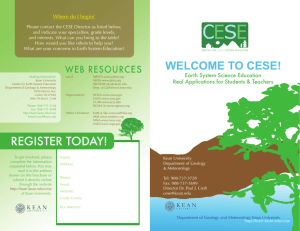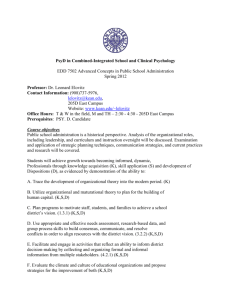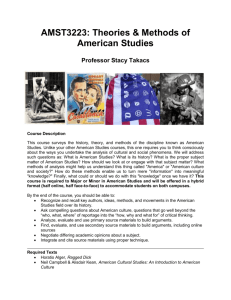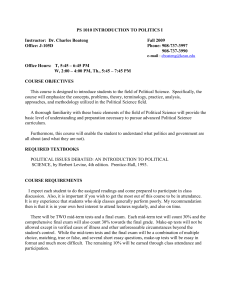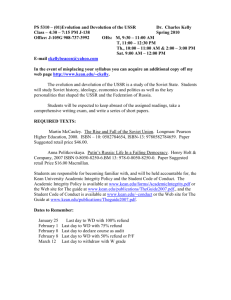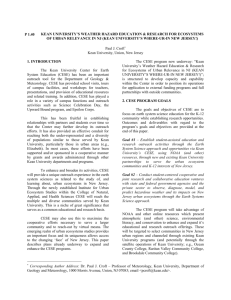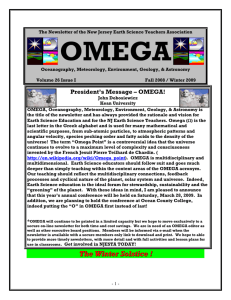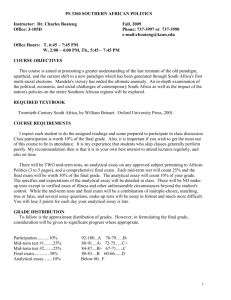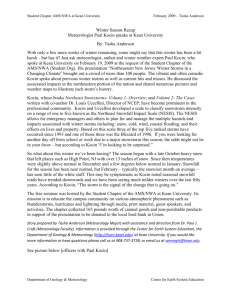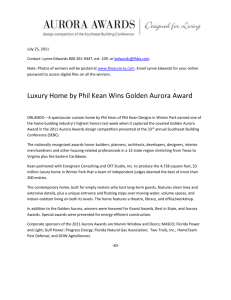Poster PDF - AMS supported meetings
advertisement
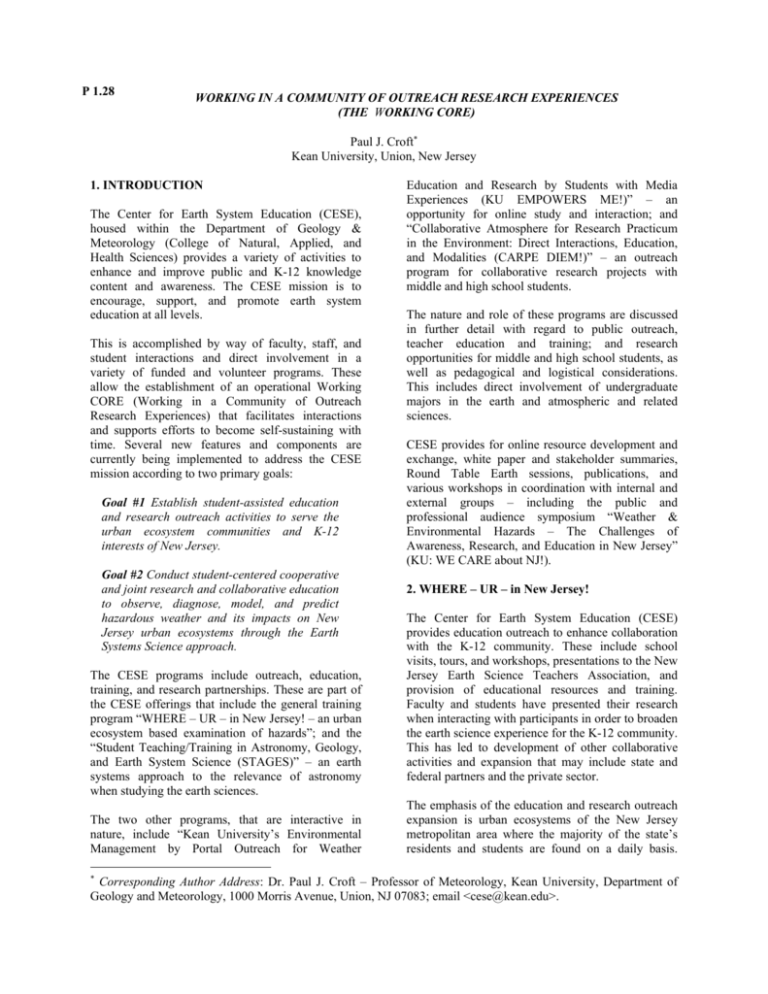
P 1.28 WORKING IN A COMMUNITY OF OUTREACH RESEARCH EXPERIENCES (THE WORKING CORE) Paul J. Croft∗ Kean University, Union, New Jersey 1. INTRODUCTION The Center for Earth System Education (CESE), housed within the Department of Geology & Meteorology (College of Natural, Applied, and Health Sciences) provides a variety of activities to enhance and improve public and K-12 knowledge content and awareness. The CESE mission is to encourage, support, and promote earth system education at all levels. This is accomplished by way of faculty, staff, and student interactions and direct involvement in a variety of funded and volunteer programs. These allow the establishment of an operational Working CORE (Working in a Community of Outreach Research Experiences) that facilitates interactions and supports efforts to become self-sustaining with time. Several new features and components are currently being implemented to address the CESE mission according to two primary goals: Goal #1 Establish student-assisted education and research outreach activities to serve the urban ecosystem communities and K-12 interests of New Jersey. Goal #2 Conduct student-centered cooperative and joint research and collaborative education to observe, diagnose, model, and predict hazardous weather and its impacts on New Jersey urban ecosystems through the Earth Systems Science approach. The CESE programs include outreach, education, training, and research partnerships. These are part of the CESE offerings that include the general training program “WHERE – UR – in New Jersey! – an urban ecosystem based examination of hazards”; and the “Student Teaching/Training in Astronomy, Geology, and Earth System Science (STAGES)” – an earth systems approach to the relevance of astronomy when studying the earth sciences. The two other programs, that are interactive in nature, include “Kean University’s Environmental Management by Portal Outreach for Weather ∗ Education and Research by Students with Media Experiences (KU EMPOWERS ME!)” – an opportunity for online study and interaction; and “Collaborative Atmosphere for Research Practicum in the Environment: Direct Interactions, Education, and Modalities (CARPE DIEM!)” – an outreach program for collaborative research projects with middle and high school students. The nature and role of these programs are discussed in further detail with regard to public outreach, teacher education and training; and research opportunities for middle and high school students, as well as pedagogical and logistical considerations. This includes direct involvement of undergraduate majors in the earth and atmospheric and related sciences. CESE provides for online resource development and exchange, white paper and stakeholder summaries, Round Table Earth sessions, publications, and various workshops in coordination with internal and external groups – including the public and professional audience symposium “Weather & Environmental Hazards – The Challenges of Awareness, Research, and Education in New Jersey” (KU: WE CARE about NJ!). 2. WHERE – UR – in New Jersey! The Center for Earth System Education (CESE) provides education outreach to enhance collaboration with the K-12 community. These include school visits, tours, and workshops, presentations to the New Jersey Earth Science Teachers Association, and provision of educational resources and training. Faculty and students have presented their research when interacting with participants in order to broaden the earth science experience for the K-12 community. This has led to development of other collaborative activities and expansion that may include state and federal partners and the private sector. The emphasis of the education and research outreach expansion is urban ecosystems of the New Jersey metropolitan area where the majority of the state’s residents and students are found on a daily basis. Corresponding Author Address: Dr. Paul J. Croft – Professor of Meteorology, Kean University, Department of Geology and Meteorology, 1000 Morris Avenue, Union, NJ 07083; email <cese@kean.edu>. Many of these regions are also located in coastal and marine environments. These offer additional unique perspectives for students and teachers alike. This also involves Kean University faculty and students across disciplines as they collaborate with one another as well as outside communities through observational data, conceptual and analytic diagnoses, modeling, and prediction. These focus on hazardous weather and the impacts of various atmospheric conditions with regard to urban locations. 3. STAGES As part of the outreach efforts of CESE participates in a variety of activities to enhance and improve public and K-12 knowledge content and awareness. These include all geospheric components as well as astronomical considerations through an earth system science approach. An upgrade to the planetarium projection unit and software (funded by the Kean University Foundation) permitted an expansion of offerings by students, staff, and faculty to these communities. This also allowed initiation of a program intended to enhance the professional development opportunities for students by allowing them to develop select demonstrations and shows for the purpose of increasing awareness and education of earth system issues and understanding. For example, tracking of the sun’s path through the sky – as a function of time of day and time of year – help illustrate a variety of weather and climate principles. Efforts have focused on the development of demonstrations, their associated pedagogy and relation to science standards at both the state and federal level, and an assessment of their application to various audiences. This includes consideration of learning objectives, hinge questions, and exploratory activities designed to increase the depth of content understanding and application. They are also in use in classroom settings at the university level for introductory courses in the earth sciences. 4. KU EMPOWERS ME! The original “Kean University: Weather and Ecosystem Monitoring, Assessment, and Prediction for Integration and Training” (KU: WE MAP IT) project was designed to establish a real-time campus ecosystem weather monitoring portal consisting of several distinct components contained within the Department of Geology & Meteorology website (http://hurri.kean.edu). These included access to on campus data and plots in time and space through secondary links provided by third parties as a prototype system. When linked to local observations they provide a real-time laboratory for exploration. At the same time, on-going and new studies were conducted with regard to campus observations through select course offerings (e.g., “Observing the Earth” – a non-science major elective; “Introduction to Meteorology” – lab-based elective; and “Meteorological Instrumentation” – upper division course for majors). The studies included observations of temperature, radiation, and other environmental features on campus as part of an environmental assessment by students. The intent was to use this data as part of an effective research and outreach approach for use by the Kean University community. In the program’s second year the KU: WE MAP-IT included the “Kean University’s Environmental Management by Portal Outreach for Weather Education and Research by Students with Media Experiences (EMPOWERS ME!)” to provide a data resource for use in various research projects and class activities which include diverse multiple groups of students from across the Kean University schools and colleges. Media integration included online materials (e.g., “Keancast” at http://hurri.kean.edu/~keancast) and in print (e.g., “Cougar’s Byte” and “The Tower”) as well as broadcasts via radio and television (see KU –TV at http://kutv.kean.edu/). Research studies were also promoted to provide applied products that are inter- or cross-disciplinary in nature. The focus was on real-time weather regimes and/or severe (or hazardous) conditions that would impact personal health, public safety, or have economic and other ramifications. The intent was to give students opportunities to partner with faculty in scholarly work that aids in their professional development and that may include collaborative activities with external partners. These serve to build the capability and capacity of faculty and students at Kean University for urban ecosystem (and other) studies. In addition, the “KU EMPOWERS ME!” program provides (a) Implementation of an outreach program of education and research using real-time campus ecosystem observations portal and online products – website, data archive distribution and guide, and pedagogy recommendations (faculty and student teams, observation manual, teaching methods guidelines); (b) Creation of weather and climate (and similar) products through research activities – basic indices of comfort, temporal and spatial studies of select parameters and phenomena, and applied operational assessments (online information, summaries, local applications); and (c) Dissemination of media information and alerts with regard to weather and environmental hazards - Kean University television and radio stations, safety tips and training documentation, and alert system (broadcast products, white paper recommendations, dissemination). 5. CARPE DIEM! A collaborative atmospheric research program envisioned by the Center for Earth System Education (http://hurri.kean.edu/cese) has also been developed to provide practical research and other opportunities for middle and high school students. The “CARPE DIEM!” program (Collaborative Atmosphere for Research Practicum in the Environment: Direct Interactions, Education, and Modalities!) is based upon initial efforts to engage high school students in research projects and activities prior to their entry into a college environment. The program provides opportunities for collaboration between middle and high school students and their peers at Kean University in the Department of Geology & Meteorology. Collaborations include research, outreach, and service activities that broaden student perspectives as they explore their interests in science and plan a college career. Students are expected to identify and select a research project during the winter to work on interactively beginning in the spring of the school year. The student then conducts a majority of the research during the summer so that in the fall they may present their efforts at their school. Projects involve relevant issues of interest in the New Jersey region including hazardous and severe environmental conditions. In the process, middle and high school students make use of their content and analytic skills according to their achievement of the science standards – at both the state and national level. Results relate to their own physical environment and have relevance to urban and other ecosystems found throughout New Jersey and the Metropolitan region. In support of their efforts, exchanges of students and faculty provide educational opportunities and experiential sessions for critical thinking development. A virtual linkage allows both access and more immediate responsiveness between middle/high school students and their counterparts at Kean University. Their participation includes visits, tours, guest presentations, field work, field trips, and similar activities. A general approach to research is provided in the context of “Earth System Science Awareness, Safety, and Action” (middle school) and “Environmental Systems: Investigate, Interrogate, and Defend” (high school). While these share common elements, the middle school level is meant to be a building block to the high school program should a student pursue a project over several years. The structure is also designed to allow ‘one-time’ experiences for middle or high school students. Students thus develop skills in the use of technology & multimedia, data, statistics, spreadsheets, mapping, plots & graphs, presentation, and writing of a paper. Outcomes include a written paper, poster, presentation to peers (and other groups), and demonstration. They provide environmentally oriented assessments with regard to understanding the problem (observe), constructing solutions (diagnose), and providing ways in which to avoid, mitigate, or prevent impacts (predict). At the high school level, projects are focused on operational research that provides or obtains new knowledge (content), identifies and proves important relationships (context), suggests meaning and use (synthesis), and leads to appropriate implementation of findings (system application). In both the middle and high school level projects students become stakeholders within their peer community and help demonstrate the utility of science. 6. WE CARE about NJ! Given that weather and related environmental hazards lead to significant impacts in the New Jersey Metropolitan region; and pose problems for a large portion of the state’s population; CESE also brought key stakeholders together to address these issues. Such environmental events have major consequences on the local economy and lead to inconveniences that adversely affect a wide range of communities (commercial, private, public, et cetera). This is particularly true during the winter season; and therefore it is important for all communities to have adequate awareness of the dangers that exist, the research concerning the occurrence and characteristics of hazards, how that information is used to improve understanding & management of hazards, and the need to be educated about those dangers & appropriate actions. To address these needs and issues Kean University sponsored the Community Symposium “Weather and Environmental Hazards – The Challenges of Awareness, Research, & Education in New Jersey (KU: WE CARE about NJ!)”. The “KU: WECARE about NJ!” symposium was delivered by the Department of Geology & Meteorology (College of Natural, Applied, and Health Sciences) and the New Jersey Center for Science, Technology, and Mathematics Education (NJCSTME, Nathan Weiss Graduate College) in association with Kean University’s Center for Professional Development. The Symposium included partners within and outside of Kean University to assist in the planning, development, and delivery of keynote and town hall sessions, training workshops, and educational sessions. A research poster forum, planetarium show, and weather and environmental fair activities were also included. These events were provided for middle and high school students and teachers, the general public, local & regional governments, private & industry professionals, federal and other sectors, and professional organizations. The symposium (www.kean.edu/~wecare) focused on weather and environmental hazards, particularly in urban settings, and the challenges faced by stakeholders in terms of community awareness, operational research, and education for the improved understanding, monitoring, assessment, prediction, warning, and mitigation of these as related to realtime management and decision-making. ACKNOWLEDGEMENTS Support from the Department of Geology & Meteorology and the Kean University Foundation is appreciated. Coordination and assistance with the Institute for Urban Ecosystems Studies, College of Natural, Applied, and Health Sciences; and Office of Research and Sponsored Programs are also noted.
